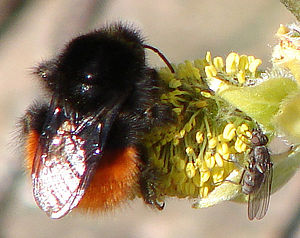Mountain bumblebee
| Mountain bumblebee | ||||||||||||
|---|---|---|---|---|---|---|---|---|---|---|---|---|

Mountain bumblebee ( Bombus monticola ) |
||||||||||||
| Systematics | ||||||||||||
|
||||||||||||
| Scientific name | ||||||||||||
| Bombus monticola | ||||||||||||
| Smith , 1849 |
The mountain bumblebee ( Bombus monticola ) is a type of bumblebee ( Bombus ).
Habitat and Distribution
The distribution area extends from Northern Europe to the Arctic. It lives in the light woods of the high mountains between 900 and 2700 m altitude. In Germany the habitat is limited to the Bavarian Alps. A colony comprises around 50–120 animals. She is one of the pollen storers . The active flying season is from late March to early September. Typical nesting sites are underground mouse nests, but also hollow trees and bird nests (nest-takers). Only one generation is produced per year (univoltin).
Mark
The mountain country queens have a body length of 18-23 mm, the workers 9-16 mm and the drones 14-15 mm. The basic color is black. The abdomen is whitish-yellow from the 1st tergite, then black from the 2nd tergite and orange-red from the 3rd to the 6th tergite. Mountain bumblebees are smaller than Alpine bumblebees. In the Alps it can be confused with meadow bumblebees and mountain bumblebees . The queen produces a high-pitched humming sound similar to that of the bumblebee . It has a short trunk.
food
Like all bumblebees, the mountain bumblebee feeds on nectar and its larvae on pollen. Their main flowering plants include, among others, anthelium , alpine roses and saxifrage .
Danger
In Germany, the mountain bumblebee is considered to be potentially endangered due to intensive agriculture and forestry and the use of pesticides.
literature
- Eberhard von Hagen: Bumblebees: determine, settle, multiply, protect . Natur-Verl., Augsburg 1990. ISBN 3-89440-546-5